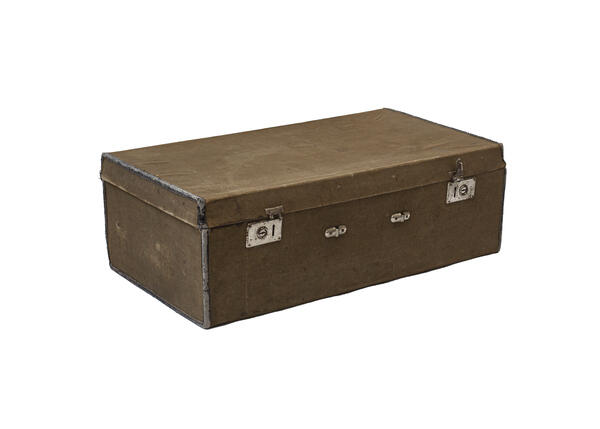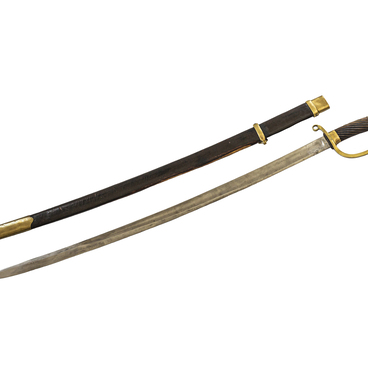The word “chemodan” (suitcase) comes from the Turkic “shabadan”. It was a narrow rectangular-shaped bag, made of thick canvas, which Turkic tribes attached to their saddles and in which they carried their belongings during migrations. There is a second version of the word’s origin, according to which “chemodan” comes from the Persian “jarmodan”. The word stood for a small case for carrying things.
Suitcases similar to modern ones appeared in the middle of the 19th century. Models lined with sailcloth were especially popular because they were particularly durable.
The sailcloth suitcase, displayed in the museum, belonged to Zoya Blyukher, the daughter of Marshal of the Soviet Union Vasily Blyukher. She took the suitcase with her on her trip from Khabarovsk to Leningrad in 1938. This suitcase, among other items, the marshal’s widow and daughter donated to the “Museum of the Revolution” in 1982. After the “Kolokolnikovs Estate” museum was established in Tyumen, it was transferred to the exposition. The suitcase is placed in the hall, dedicated to the marshal. Blyukher’s headquarters were located at the estate for three months in 1919.
Vasily Blyukher was born into a peasant family in a village in Yaroslavl governorate in 1890. He studied for a year in a parochial school, but in 1904 his father took him to St. Petersburg. Blyukher worked part-time in a store, and later as a laborer at the Franco-Russian Machine-Building Plant, from which he was fired for participating in workers' rallies. Trying to make a living, he moved to Moscow, and in 1909 he became a locksmith at the Mytishchi Railway Car Building Works. A year later, he was arrested for calling for a strike.
Blyukher served during the First World War, where he was seriously wounded due to a grenade explosion. He then joined the Bolshevik Party (Russian Social Democratic Labor Party). He took an active role in the establishment of Soviet power in Samara and Chelyabinsk. As a commander of various brigades, Blyukher fought on the side of the Red Army in the Urals, Western Siberia, Transbaikalia, and in the south of Russia during the Civil War. In the summer and fall of 1919, he took part in operations in Tobolsk governorate, and commanded the 51st Rifle Division. The building which housed the headquarters of that division in Tyumen survived to this day.
Vasily Blyukher became the first recipient of the Order of the Red Banner and the Red Star. From 1929 to 1938, he commanded the Special Red Banner Far Eastern Army. In October 1938, he was falsely accused of participation in an anti-Soviet right-wing organization and in a military conspiracy to overthrow the Soviet government and subsequently arrested. On November 9, 1938, Blyukher died during his interrogation in the NKVD (People’s Commissariat for Internal Affairs) detention center in Moscow. He was rehabilitated posthumously in March 1956.
Suitcases similar to modern ones appeared in the middle of the 19th century. Models lined with sailcloth were especially popular because they were particularly durable.
The sailcloth suitcase, displayed in the museum, belonged to Zoya Blyukher, the daughter of Marshal of the Soviet Union Vasily Blyukher. She took the suitcase with her on her trip from Khabarovsk to Leningrad in 1938. This suitcase, among other items, the marshal’s widow and daughter donated to the “Museum of the Revolution” in 1982. After the “Kolokolnikovs Estate” museum was established in Tyumen, it was transferred to the exposition. The suitcase is placed in the hall, dedicated to the marshal. Blyukher’s headquarters were located at the estate for three months in 1919.
Vasily Blyukher was born into a peasant family in a village in Yaroslavl governorate in 1890. He studied for a year in a parochial school, but in 1904 his father took him to St. Petersburg. Blyukher worked part-time in a store, and later as a laborer at the Franco-Russian Machine-Building Plant, from which he was fired for participating in workers' rallies. Trying to make a living, he moved to Moscow, and in 1909 he became a locksmith at the Mytishchi Railway Car Building Works. A year later, he was arrested for calling for a strike.
Blyukher served during the First World War, where he was seriously wounded due to a grenade explosion. He then joined the Bolshevik Party (Russian Social Democratic Labor Party). He took an active role in the establishment of Soviet power in Samara and Chelyabinsk. As a commander of various brigades, Blyukher fought on the side of the Red Army in the Urals, Western Siberia, Transbaikalia, and in the south of Russia during the Civil War. In the summer and fall of 1919, he took part in operations in Tobolsk governorate, and commanded the 51st Rifle Division. The building which housed the headquarters of that division in Tyumen survived to this day.
Vasily Blyukher became the first recipient of the Order of the Red Banner and the Red Star. From 1929 to 1938, he commanded the Special Red Banner Far Eastern Army. In October 1938, he was falsely accused of participation in an anti-Soviet right-wing organization and in a military conspiracy to overthrow the Soviet government and subsequently arrested. On November 9, 1938, Blyukher died during his interrogation in the NKVD (People’s Commissariat for Internal Affairs) detention center in Moscow. He was rehabilitated posthumously in March 1956.



